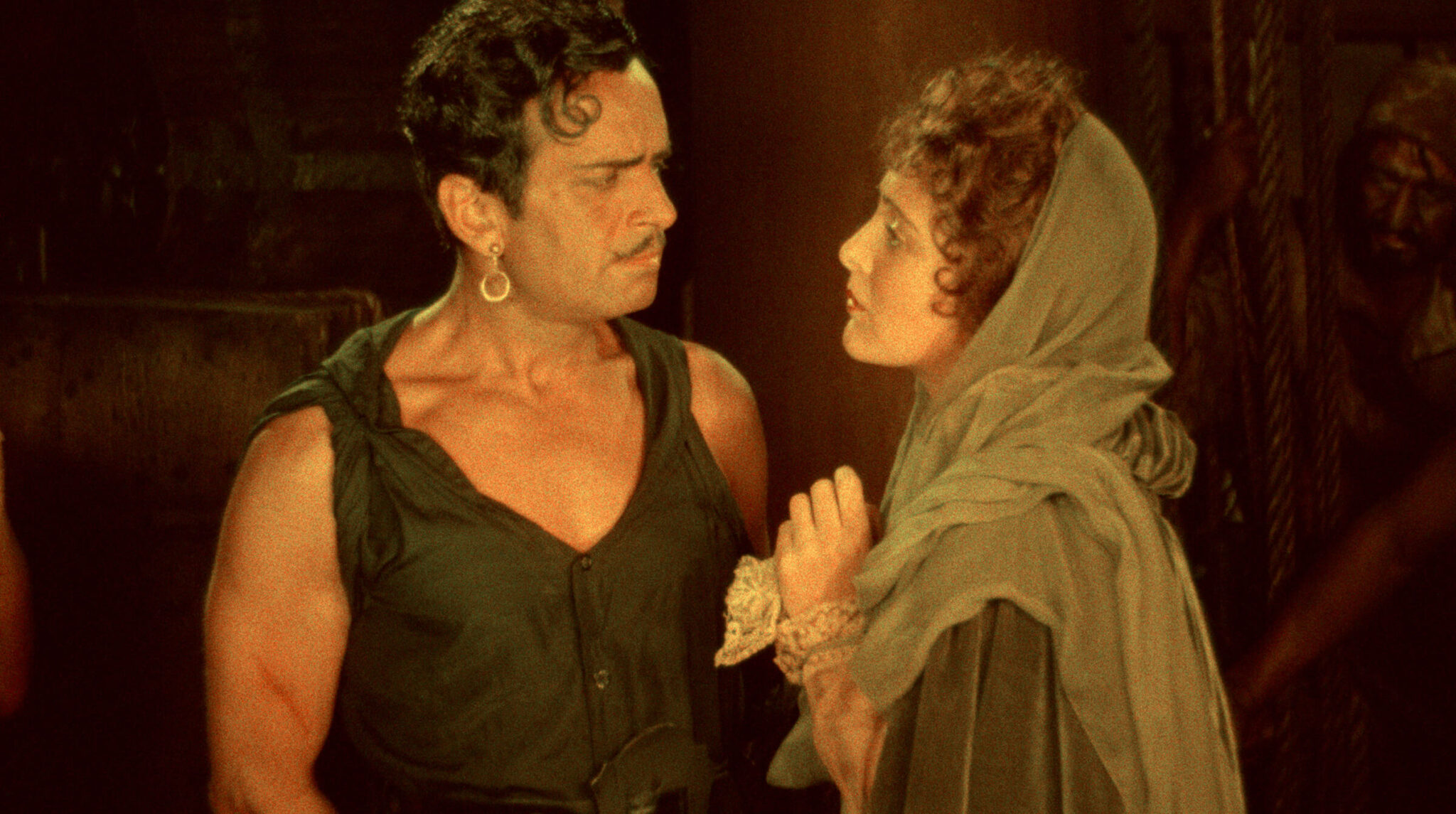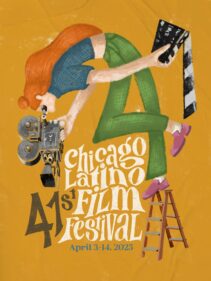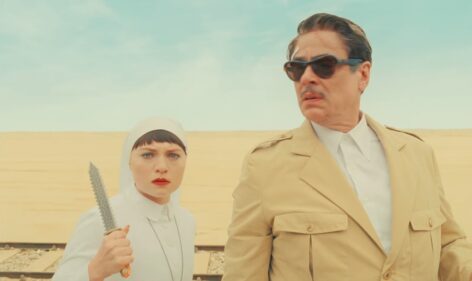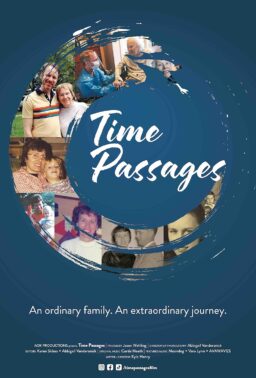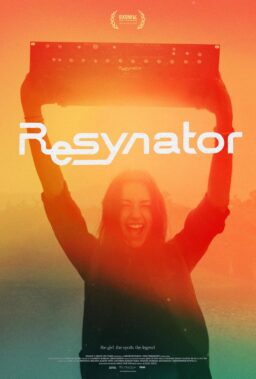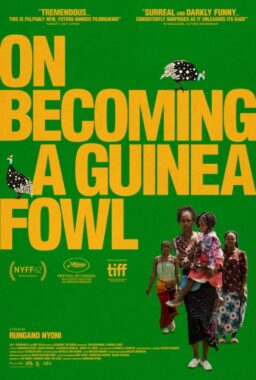For the past twenty-seven years the San Francisco Silent Film Festival has unearthed treasures from the silent film era and presented them with context and curation for audiences of the City by the Bay. Over the decades the festival has grown from presentation only to an organization that helps restore and preserve this fragile art. When I lived in San Francisco during grad school over a decade ago, I was lucky enough to attend many events hosted by SFSS, from their flagship festival back when it was hosted at the historic Castro Theatre to their epic presentation in 2012 of Abel Gance’s “Napoleon” at the Paramount in Oakland, with the late Carl Davis conducting the Oakland Symphony. I was so happy to finally return to this glorious festival, where the lure of shimmering celluloid is somehow more beguiling than a sunny springtime day in San Francisco.
This year the festival has moved to the equally stunning Palace of Fine Arts, located just a stone’s throw from the Golden Gate Bridge. Over the course of five days, this year’s festival screened over 26 feature films, shorts, and fragments from the early days of cinema. As you take your seats in the auditorium, a curated slideshow shares factoids about each film, archival photos, vintage lobby cards and more, paired with music to set the mood. As the films screen, they are accompanied by soul-stirring scores played live by some of the most talented musicians in the game, and put into context through thoughtful introductions by a cadre of curators, archivists, and historians.
Opening night began with a sparkling new restoration of the pirate epic “The Black Pirate” starring that dynamic swashbuckler himself, Douglas Fairbanks. The Donald Sosin Ensemble wore cheeky skull and bones-style pirate hats as they played their lively score. After opening remarks from longtime president of the board Robert Byrne, a filmed introduction featured director and board member Alexander Payne explained how the funding for this new restoration came from Hollywood Foreign Press Association, and was carried out by the Museum of Modern Art, The Film Foundation, and the British Film Institute.
And what a restoration it was! The luminous, other-worldly qualities of two-strip Technicolor have never looked better, especially as used by cinematographer Henry Sharp, who was inspired by the paintings of the Dutch masters. Although some moments were a bit shaky, most of the print had crystal clear clarity to the point that you could see such small details as tattoos on the chest of a pirate or the exquisite texture of the dress worn by Billie Dove’s Princess Isobel. I don’t think Fairbanks has ever had more swag than he does in this role, and watching the impressive sea battles was thrilling, reminding me of Peter Weir’s maritime masterpiece “Master and Commander”.
The second day of the festival began in the morning with another great edition of Amazing Tales from the Archives, a free program where archivists and scholars share their work with the public. The BFI National Archive’s Bryony Dixon began the program with a presentation on how director Michael Powell got his unlikely start in the movies as a teenager in the French Riviera. Through a series of letters that he wrote home to his mother in England, Dixon illuminated how the future master filmmaker fell in love with moviemaking from the ground up, first working on “Mare Nostrum” directed by Rex Ingram. You see, Hollywood filmmakers had flocked to the Riviera for the locals, but also because they could legally get sloshed. Later, Powell starred in—and sometimes composed shots for—a series called “Travelaughs,” which was a satirical travelog series. Dixon presented clips from the series, in which Powell plays a character called Cicero Simp, showing the director to be a surprisingly skilled physical comedian.

Author and scholar Denise Khor presented her research on the 1914 film, “The Oath of the Sword,” which was the first American film to have an all-Japanese cast. The melodrama was made by the Japanese American Film Co. established in 1913 by a conglomerate of businessmen of Japanese descent. Unfortunately, this was their only completed film. After Khor’s insightful presentation, a digital version made from a 35mm print from George Eastman House of the film was screened. While its politics may not have aged well, it’s a rare treat to see such a unique piece of film history preserved and presented over a hundred years after its inception.
The final presentation of the program was from historian and co-author of “The Dawn of Technicolor” David Pierce, who recently retired from the Library of Congress. Through his illuminated and colorful lecture, Pierce took us on a journey through the productions of the first four feature films made in Technicolor, culminating in the making of “The Black Pirate.” A clip from the fragment “Red Hair” starring Clara Bow was also shared, which was a neat way to tie this program with the festival’s next offer …
… two Clara Bow restoration premieres! The first of the double feature was the recently discovered short film “The Pill Pounder,” which was followed by the zippy melodrama “Dancing Mothers.” In his introduction Bow scholar David Stenn explained how the short was just recently discovered in a parking lot sale in Omaha, Nebraska by collector and filmmaker Gary Huggins. One of a series of Charlie Murray comedies made in 1923, the film was directed by Gregory La Cava and featured a vibrant, wild-haired teenaged Bow as the daughter of the titular pill pounder, 20s slang for pharmacist, who would rather play poker with his buddies than run his shop. The print was a truncated version made for mid-century audiences which removed the inter-titles and some of the footage in order to condense its run time. Stenn emphasized that this restoration—done earlier this month by the festival and is absolutely gorgeous—is a work-in-progress and they are determined to find the missing footage.
Although not top billed in “Dancing Mothers,” the exuberant Bow steals every scene in this melodrama playing a jazz baby nicknamed “Kittens,” who falls for a cad named Jerry Naughton (Conway Tearle) while on steamer trip home across the Atlantic with her father Hugh (Norman Trevor). Neglected by her husband and daughter upon their return, Ethel (Alice Joyce) decides to go out to a speakeasy herself one night. There she meets Hugh and things get dicey when instead of teaching him a lesson, the duo fall in love. Although the film revels in the vices of the era – booze and dancing and bias-cut gowns abound – at its heart it is critical of how overindulgence can lead towards selfishness, not just freedom.

The day continued with an uproarious screening of “Oh! What a Nurse!,” starring Syd Chaplin, whose singular slapstick talents were often overshadowed by those of his much more famous brother, Charlie. The film also featured a charming turn from Patsy Ruth Miller, whose velvet outfit in the final sequence was nothing short of enviable. In his introduction, AMPAS’ Randy Haberkamp called restoration work “archival detective work,” as groups work together to find the best possible way to restore these films to their original glory. In a second introduction, Pordenone Silent Film Festival Director Jay Weissberg thanks Lobster Films’ Serge Bromberg for the print, and then gave an impassioned history lesson on the history of female impersonation—an art that was extremely lucrative and popular with audiences at the turn-of-the-century—tying that history and this film into the current spate of drag bans across the nation.
The first evening show of the day was Frank Borzage’s “The Lady,” starring the incomparable Norma Talmadge. I first saw this film a few years back as part of the online component of Pordenone, but I may as well have never seen it for how much the big screen transformed the experience. Talmadge at one point was a huge star, one of the first actress-celebrities, making her name in women’s pictures—melodramas for working class women who want to see a little glitz, but also want to see someone who has it worse off than they do. In his introduction for the film, David Pierce said, paraphrasing Norma Desmond, that they really did have faces then. And what a face Talmadge had! The film begins with her as Polly Pearl, the aged proprietress of a British pub in Marseille, who recalls her days as a London dance hall girl who fell for a rich man who, naturally, abandoned her—and their child—to the streets. Talmadge plays every emotion—and every age—with a precision and nuance that simply can only be done justice when projected on the big screen.
“In these harsh times, it’s good to swash a few buckles,” was the message Senior Film Restorer Kathy Rose O’Regan had for the audience as they prepared to buckle up for Frank Lloyd’s 1924 high seas epic, “The Sea Hawk,” which was filmed on location on Catalina Island with over a thousand extras and crew members. Only at festivals like SFSFF will you hear an audience cheer at the mention of an actor like Chicago’s own Milton Sills, a matinee idol who died in 1930 at the peak of his stardom. Like Fairbanks, Sills had a commanding physical presence, if not quite as lithe, and he owns every minute of this wonderfully peculiar pirate picture.

Friday morning began with “The Opportunist,” a Soviet-Ukrainian satire about a small-time black-marketeer, a camel, and the perils of partisanship. In his introduction to the film, scholar Stas Menzelevskyi remarked of the many things the audience could be doing in San Francisco on a beautiful Friday morning, we had chosen the most unorthodox one, and, he hoped, the most rewarding. For my money, he was right. While the satire was aimed specifically at the society of Soviet-Ukraine in 1929, much of its criticisms could be lobbied at any number of bureaucracies, political factions, and profiteers today.
This film was followed by Allan Dwan’s drama “East Side, West Side,” which was filmed on location around New York at a time when the cityscape of Big Apple was rapidly changing. George O’Brien, probably best known now for his turn in “Sunrise,” stars as a young man named John who is reared on a tugboat that hauls bricks but dreams of building skyscrapers. After a fire renders him alone and homeless, he finds a new home with a family of Jewish immigrants, before making his name as a boxer and ultimately finding fame as a builder. This was another film I had already seen thanks to the Criterion Channel but seeing Dwan’s astonishing use of locations on the big screen felt like taking a time machine back to the New York City of the 1920s.
Historian, author, and proprietress of Silent London Pamela Hutchinson was on hand to introduce the next film, Julien Duvivier’s “Poil de Carotte” from 1925. I would like to thank her for introducing the phrase, “lavatorial gaslighting” into my vocabulary. Based on Jules Renard’s autobiographical novel of the same that traces the life of a neglected and abused boy in an isolated French village, Duvivier felt so connected with the material that he remade the story as a sound film in 1932. Having now seen both, I see why Duvivier often cited his silent film among his favorites of his own films. His use of double exposures to evoke the boy’s various emotional states is amongst the best I’ve ever seen. Noir fans may be familiar with Duvivier’s film “Panique” from 1946, and while the films don’t have much in common plot-wise, they explore similar themes around the destructive power of gossip.

The evening began with a riotous screening of Harry A. Pollard’s “Poker Faces,” starring the great Edward Everett Horton and Laura La Plante as a husband and wife whose marital spat leads towards a farce of mistaken identity so convoluted it must be seen to be comprehended. The comedy finds itself comfortably set between slapstick and bedroom farce, while laying the groundwork for the screwball comedies of the 1930s, many of which featured Horton in scene-stealing supporting roles. Pollard is not well remembered today, though I do recommend seeking out his 1924 Reginald Denny comedy “The Reckless Age” and the pre-code comedy “Shipmates” starring Robert Montgomery. The Kansas-born Pollard’s papers are held at Wichita State University, and in his introduction, Jay Weissberg hoped perhaps a scholar out there might take on the task of combing through them. What treasures they may hold remains unknown.
The evening ended with one of my all-time favorite films, Benjamin Christiansen’s “Häxan,” which was brought to life by a truly haunting score performed live by the Matti Bye Ensemble. The most expensive Scandinavian film at the time, the film traces the history of witchcraft from its pagan roots to the Spanish Inquisition to the psychoanalysts of the 20th century. Filled with lurid imagery of torture, satanic orgies—Christiansen himself plays the Devil—and possessed nuns, this singularly bizarre film remains as beguiling and strange today as it did over a hundred years ago. I rewatch it every year around Halloween. But seeing it on the big screen was a truly transcendent experience. I also loved the introduction by the Danish Film Institute’s Thomas Christiansen, who has been working over the last five years to make every extant Danish silent film available streaming.
When I used to attend the festival in the past there would be lots of people dressed in period duds. Although this wasn’t the case so much this year, I was so pleased when I entered the lobby ahead of the Saturday morning screening of a trio of Laurel and Hardy shorts to see a family in matching “Another Fine Mess” t-shirts and a father and son in matching red fezzes emblazoned with the “Sons of the Desert” logo. Bryony Dixon returned to introduce the three shorts from 1928—“You’re Darn Tootin’,” “Two Tars,” and “The Finishing Touch”—giving a splendid overview of how these two disparate souls from Lancashire, England and Harlem, Georgia created a transatlantic comedy duo for the ages. Described as masters of the “comedy of escalation,” these three shorts could serve as a masterclass in choreographed chaos as the duo manage to destroy an orchestra, several dozen cars, and even an entire house with aplomb. The audience was probably the most mixed in ages of the entire festival, and I must say hearing children howling with laughter at comedy gags that are nearly one-hundred years old must be one of life’s most special treasures.

The tone changed dramatically with the next feature, William Wyler’s “Hell’s Heroes,” an early adaptation of Peter B. Kyne’s novel “The Three Godfathers.” Wyler’s daughter and SFSFF board member Judy Wyler Sheldon introduced the film, saying that Wyler felt the many westerns he had made early in his career were his “film school,” and that he often would stay up nights thinking of different ways to film an actor getting on and off a horse. The film centers on three bank robbers—Charles Bickford, Raymond Hatton, and Fred Kohler—who hightail it to the desert with their treasure, only to find a dying woman and her newborn baby. The trio make a promise to bring the baby, whose father was the cashier they murdered, back to the city before Christmas. The film was shot on location in the Mojave, with a wonderfully evocative use of the native Joshua trees.
The film was followed up by Yasujiro Ozu’s charmer “I Was Born, But …,” a film I have seen on the big screen three times now but will never balk at the chance to see again. Tatsuo Saitō and Tomio Aoki co-star as a pair of brothers whose father has moved the family out to the suburbs. The two find it a rocky path adjusting to their new life, getting into several kerfuffles with the local boys and slowly realizing their dad may not actually be the “big shot” they thought he was. The film was loosely remade by Ozu many years later as “Good Morning,” with both films featuring Ozu’s trademark mixture of humor tinged with melancholy.
Another selection I had seen as part of Pordenone online but whose qualities were brought to even more startling life by the magic of the big screen was Karl Grune’s “The Street,” a film that had such an impact on Weimar Era Germany that it spawned a whole genre of “street” films known as Strassenfilm, and whose lasting impact can trace itself all the way to emigres who came to Hollywood and made what we now call Film Noir. Grune believed that cinema should be an art made purely of movement, so there are few inter-titles in the film, just pure visual storytelling. Although the whole film was made on a soundstage, the film effectively evokes the grime and the glittering allure of city nightlife, as we follow an everyman (Eugen Klöpfer) down a path towards temptation that may turn lethal.
Just when you think the festival is going a little too dark, Buster Keaton comes to save the day. The house was packed for a twofer of “One Week” and “Sherlock, Jr.,” two films I have seen on the big screen many times, and likely will see many times more. Few stars can rival the legacy of the Great Stone Face and his ability to elicit thunderous laughter without fail time and again. Artistic Director Anita Monga read from James Agee’s 1949 Life Magazine essay “Comedy’s Greatest Era” in her introduction. My favorite bit of the excerpt reads, “With the humor, the craftsmanship and the action there was often, besides, a fine, still and sometimes dreamlike beauty.” I can’t think of a better way to describe something like “Sherlock, Jr.,” in which Keaton plays a projectionist studying to be a detective who dreams himself into a mystery film. I know that there has been much written about the special effects of how Keaton literally walks into the screen, but I prefer to just think of it as the purest of cinematic magic.

The final film of the night was “The Joker,” a Danish-German romp with a British leading man (the incredibly hunky Henry Edwards) and filmed on location in Nice. Set during Carnival, Edwards plays a suave highroller who helps a couple of sisters out of a blackmail plot by a shady lawyer (Miles Mander). Thomas Christiansen returned to introduce the film and promised that it would feature enough champagne and paper streamers to last a lifetime. He was not wrong. One sequence in which Edwards and his lady love (Elga Brink) are bound together by what appears to be several miles worth of paper streamers manages to be both silly and incredibly sexy at the same time.
The final day of the festival began with a discovery title. Alfred Santell’s “The Gorilla” begins as a bit of an old dark house mystery—taking cues from Edgar Allan Poe’s “The Murders in the Rue Morgue” and maybe even laying a path to “King Kong”—before succumbing to some baser farcical comedy that ultimately stretched the film out way too long for my taste.
This was followed by the Harold Lloyd classic “The Kid Brother,” co-starring the ethereal Jobyna Ralston, and one of my favorite animal actors: Jocko the monkey! The bespectacled Lloyd plays the black sheep in a family full of burly men who falls hard for a girl in a traveling medicine show. When the shady dealers in the show steal the town’s funds, Lloyd gets the chance to prove his worth and get the girl. While Lloyd’s sweet and shy charm doesn’t always work for me, it did here, especially when accompanied by the Mont Alto Motion Picture Orchestra’s jovial score.
The final Scandinavian film of the festival was Victor Sjöström’s “The Phantom Carriage,” another film I will literally see every chance I get on the big screen. Sjöström stars as a down-and-out man whose severe alcoholism has pushed his family away. On New Year’s Eve, he’s greeted by the grim reaper who gives him a chance to turn his life around. Not only does Sjöström give a soul-stirring lead performance, his use of double, triple, and sometimes even quadruple exposures to craft a level of nonlinear storytelling that rivals Nolan’s “Inception” in its inventiveness.

The penultimate film of the festival was G.W. Pabst’s “The Devious Path,” starring Brigitte Helm as the restless wife of a lawyer who finds herself tempted by the pleasure of the Weimar Era nightlife. While both Pabst and Helm are best known for their work on masterpieces like “Pandora’s Box” and “Metropolis” respectively, this film should not be considered a minor work for either. Pabst’s fluid camerawork and knack for complex staging is in full effect, while Helm gives one of the most complex performances of her career. I would be remiss, though, if I didn’t mention Gustav Diessl as her controlling husband, whose face game has few rivals. I also found it fascinating how you could pretty much take this plot out of Weimar Germany, remove some of its seriousness, and it would make a pretty fun marriage-remarriage screwball comedy.
The festival ended with one final restoration, James Cruze’s “The Red Mark,” a 1928 melodrama set on a South Seas penal colony. Although largely forgotten now, Cruze was one of the leading directors of his era, with hits like the 1923 epic “The Covered Wagon” and the lost film “Hollywood” (which has for my money one of the greatest posters of all time). Gaston Glass stars a Bibi-Ri, a pickpocket set for release, whose romance with the fair Zellie (Nina Quartero) is threatened by the colony’s ruthless, guillotine-crazed governor De Nou (Gustav von Seyffertitz). I was not very familiar with these three leads, and I must confess I kept imagining what the film would have been like with a genuine star like John Gilbert or Ramon Novarro playing the romantic lead. But I was completely beguiled by Nina Quartero, who must have the saddest eyes I’ve ever seen.
As the flickering light of the final scene faded to black and the curtain closed on the festival, I found myself exhausted, overwhelmed, and exhilarated. As saddened as I was that the whole affair was over (until next year, that is!), ultimately attending a festival like the San Francisco Silent Film Festival, that is so rooted in the deep love of preservation and presentation, of discovery and reappraisal, of cinema as a community, is a priceless experience. I walked out into the crisp night air of the City by the Bay, and felt nothing but rejuvenated, replenished, and renewed.

